Dinosaur fossils are on spectacular display at Dinosaur National Monument, near the Green and Yampa rivers on the border between Utah and Colorado. A famous quarry in the monument, discovered in 1909, contains thousands of dinosaur bones. Paleontologists have partially excavated many of these fossils and they are on display for visitors. A sandstone bed with a rich variety of fossils and tilted up to an angle of about 67 degrees, forms an impressive “Wall of Rock” that is within close viewing distance. I first saw this fabulous exhibit when I was a child, and whenever I have visited it again in past decades, I have continued to feel absolute awe at the sight of the massive bones mishmash.
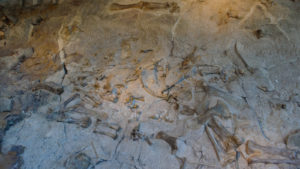
Quarry exhibit at Dinosaur National Monument (Wikimedia)
How such a tremendous collection of dinosaur remains could accumulate approximately 150 million years ago has fascinated many ever since discovery of this quarry. Like a puzzle with missing pieces, there are tantalizing bits of information that don’t fit neatly together.
My memories of Dinosaur National Monument were stirred by a recent blog post on Volcano Café (one of my favorite blog sites and mentioned in many of my previous posts). The post, written by Albert, has an excellent description of the Monument’s regional geology, the natural environment at the time the dinosaurs roamed, and a discussion of how the bones were most likely deposited. Here is the link: https://www.volcanocafe.org/death-of-dinosaurs/
I’ll give away some of the story. The Morrison Formation, which contains the dinosaur quarry, has significant amounts of volcanic ash. This ash blew into the region from the erupting volcanoes associated with subduction far to the west along the Pacific coast. Bone deposits are in sandstone, showing that flowing water was involved, perhaps in a riverbed or floodplain. There are at least 20 individuals of 10 different species of dinosaurs in the quarry; we consider this jumble of bones to be a “death assembly” — that is, the animals died elsewhere and then were transported into a low point, where sediments rapidly covered them. Different degrees of preservation of the bones suggest the possibility of death caused by a drought, or by some sort of catastrophe, like a flash flood. Unraveling the details of these possible events, however, is tricky—to learn more, check out the post!
Jurassic Park and Beyond
One of the many things I learned from Albert’s post is that the movie Jurassic Park is filled with Cretaceous era dinosaurs— ones that lived tens of millions of years after the close of the Jurassic. I suppose those dinosaurs just seemed more interesting for Michael Crichton when he was writing the novel upon which the movie is based — plus maybe Cretaceous dinos look better on a big screen? Also, perhaps the name “Cretaceous Park” doesn’t have the same ring? Curious about other scientific inaccuracies in that movie, and with the vast information of the web at my fingertips, I found other interesting details. Among these, I learned that the media franchise of Jurassic Park (also referred to as Jurassic World) has churned out six films. The last of these films, called Jurassic World: Dominion (a catchy title!) is due to be released in June 2022. I saw the original Jurassic Park on a big screen decades ago, and while I vaguely remember hearing about sequels, I haven’t seen any. But someday, maybe I will.
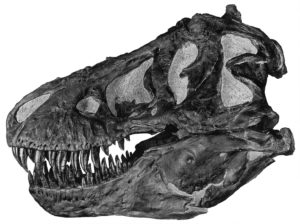
Complete Tyrannosaurus rex skull, American Museum of Natural History. https://commons.wikimedia.org/wiki/File:Tyrannoskull.jpg
For the initial Jurassic Park, released in 1993, director Steven Spielberg and filmmakers worked with paleontologists to reflect current scientific research about dinosaurs. This information included the speed and agility that many dinosaurs possessed, and since many people still thought of dinosaurs as slow and stupid, those were valuable facts to share.
There was some “artistic license” in the movie as well. The dinosaurs that starred in Jurassic Park, specifically, Tyrannosaurus rex and Velociraptor, weren’t quite accurate. For example, T. rex chased a jeep that the panicked driver was flooring, suggesting a speed of around 60 mph (96 km/hr). Scientists believe the actual top speed of this enormous creature would have been closer to around 15 mph (24 km/hr) (T. rex specimens of up to 40 ft/12 m long are known, with skulls 5 ft/1.5 m long. Plus LOTS of teeth.). The terrifying movie scenes with Velociraptor show those animals as much larger than life. In addition, the movie dinosaurs actually were based on a different beast, Deinonychus antirrhopus, but once again, “Deinonychuses” doesn’t have such a catchy ring.
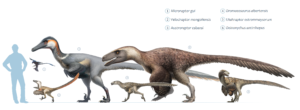
Small Velociraptor (next to feet of human), Deinonychus (lower far right), and feathery friends. Very large Utahraptor was classified shortly before release of the 1993 Jurassic Park movie. (Wikipedia)
For more details from the source where I found this and much more interesting information, check out https://en.wikipedia.org/wiki/Dinosaurs_in_Jurassic_Park. (NOTE: now I’ll put in a plug for Wikipedia, an invaluable source of information. If you use it, please support this non-profit organization by donating – and yes, I’m a monthly donor; I consult the website frequently.)
Movie producers, of course, specifically designed the dinosaurs in the film series to be crowd-pleasers. Still, given the power of movies to shape people’s knowledge, filmmakers could have more accurately portrayed the amazing variety and strangeness of these creatures that once dominated our planet – not doing so was a missed opportunity. Among the new information that has been available for a few decades is that many dinosaurs had bodies covered with feathers, spines, and quills. This information has been slow to reach the public. Subsequent movies released in the franchise didn’t help, as they stayed with the public image of what people expect: scaly reptiles. Apparently, that is changing, as the latest film, Jurassic World: Dominion, reportedly has feathered dinosaurs. But, and just guessing here — other aspects of that film will most likely be quite a stretch, at least from a scientific perspective.
Dinosaur Fossils for Sale
In other dinosaur news, Christie’s auction house has scheduled a sale of a Deinonychus skeleton for May 12, 2022. Excavated on private land in Montana, some bones are the originals, others reconstructed. A price tag of around $5 million is estimated.
To me, private ownership of rare fossils tens of millions of years old is wrong. They are our heritage; they belong to everyone, and they should be available for study by scientists and exhibited in museums open to the public. Museums have recently purchased some important fossils. Others disappear, like the T. rex nicknamed “Stan” and sold in 2020 to an anonymous buyer for $31.8 million. National Geographic recently reported that Stan is now in Abu Dhabi, and officials are planning to include the skeleton in a new natural history museum. Still, with all the billionaires currently on the planet, public institutions could easily be left out of competitive bidding for future fossils. And yeah — this is just one more annoying reality of modern times.
ALSO…. In the next few weeks, I’ll be traveling and probably won’t post for awhile—but I’ll be back!
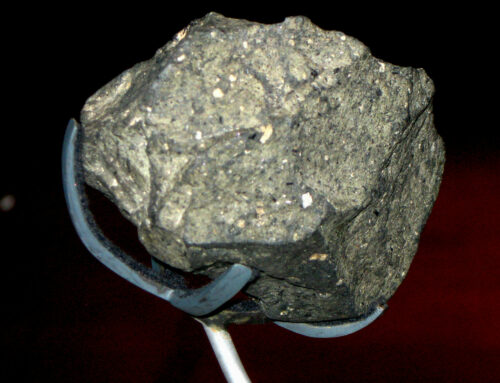
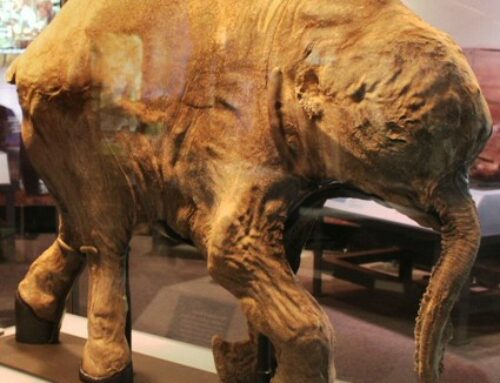

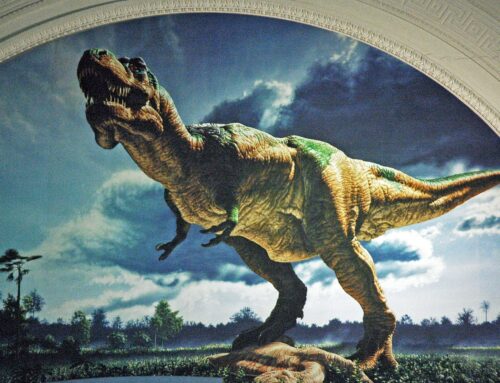
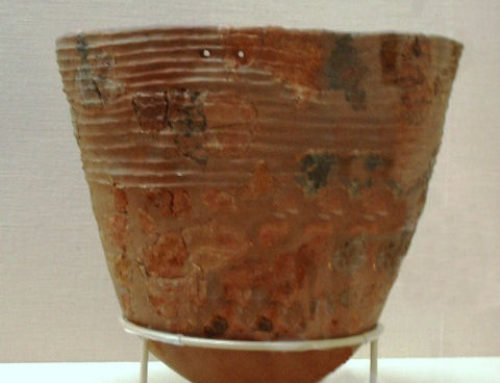
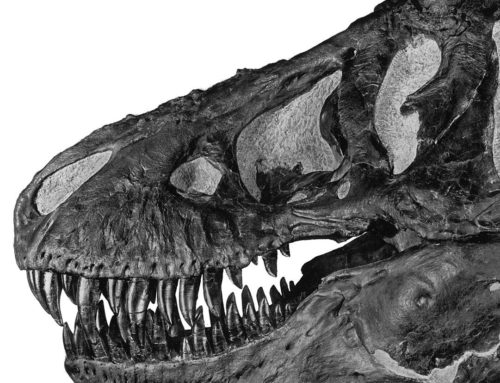
Great post!
Thanks!
I like the post! The Jurassic sequels are fun and entertaining. Some cloning and mixing of genes going on, interesting ideas. But far from reality of course.
Dinosaurs indeed do belong in museums, not toys for billionairs. Do they even know how to take care of those old, fragile fossil bones?
Thanks, Kathelijne! One of these days I’ll check out some of the movie sequels. And yes about fossils not being toys for billionaires!
Thanks, Roseanne, for another fascinating and well written article. And thanks for the link to VolcanoCafe. Looking forward to your next article.
Thanks, Larry!
Estimates were a little off – auction sale went above $12 million! I guess I’ll never be able to afford my own dinosaur skeleton.
Interesting and I was disappointed about the movie producers not being accurate but it’s all about making a buck unfortunately for some people.